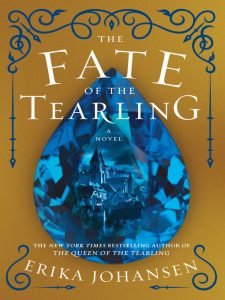Review of the Queen of the Tearling Series by Erika Johansen
Felicia Gullotta // Blog Writer

For those unfamiliar with the series Queen of the Tearling by Erika Johansen, I’m sorry for your loss. However, there is a way to atone for such a crime: run to your nearest library or bookstore and grab yourself a copy of this whirlwind of a fantasy trilogy.
Johansen has created a fantastical universe full of remarkable characters that readers will fall in love with over and over again. The series focuses on Kelsea who has just turned nineteen years old, making her eligible to reclaim her mother’s throne as the Queen of the Tearling. Fighting to claim and keep her rightful title, readers meet a loyal band of men who make up the Queen’s Guard—a little rough around the edges, but whose commitment to protecting Kelsea is at times utterly heartbreaking—and a mysterious thief called the Fetch. But getting her throne back isn’t easy; her uncle, acting as Queen’s Regent, isn’t willing to relinquish power, and all the while trouble brews in the East in the form of the Red Queen, an immortal dictator who strikes fear into the hearts of the bravest men and women.
The Queen of the Tearling series is propelled by a strong female protagonist in the character of Kelsea, but also by a compelling and mysterious female villain, the Red Queen. As a female reader who loves fantasy, it’s a relief to find something so well written with these amazing female leads. There are times when it feels like Kelsea spends a little too much time noticing the physical appearance of the men in her guard, but Johansen does a great job of spending a majority of Kelsea’s focus on saving her kingdom.
Overall, the series deserves a solid B+.
(Warning: The rest of the article contains spoilers, specifically around the final book, Fate of the Tearling, which was published Nov. 29, 2016.)
With such high praise of the book, that B+ rating might seem harsh, if not a little low. I was almost tempted to rate it lower, if only because of the very last edition to the series, Fate of the Tearling. The book is written as well, if not better, than the preceding books. The trials faced by Kelsea and her Queen’s Guard tugs on the heartstrings of readers and will have them unable to read fast enough.
However, Johansen seems to take a cop-out in an effort to save the Tearling and give Kelsea her wish—to fulfill a vision of a socialist utopia. It’s no easy task as the kingdom is full of corruption and most of its population is a desolate poor barely able to make ends meet. Add in the fact that the Tearling is surrounded by two other kingdoms that have repeatedly decimated the Tearling army in their war mongering and Johansen has put a lot on Kelsea’s plate for clean-up.
This might be why Johansen started setting up a plan in the second book, Invasion of the Tearling for time traveling in book three, Fate of the Tearling. You read that correctly, time traveling. It felt as much of a cop-out in the book as it does in this article.
Johansen stacked the odds so against Kelsea: her country barely has an army, the neighboring countries are so powerful as to never be conquered, the Tearling is without allies, there’s the introduction of a mythical force who also wants to rule the Tearling. Oh, and that mythical force just happens to have an army of immortal demon-children. It felt as if Johansen either became overwhelmed with how much she put up for Kelsea to try to rule or she herself became overwhelmed by it. She either needed another three books specifically devoted to cleanup if she hadn’t used time traveling.
But time traveling isn’t as neat and tidy as it sounds. Especially in the last book, there is still mystery surrounding how Kelsea’s jewel—a Tearling sapphire—has the capability to send her backwards into time. Not only is the how part of time traveling left unexplored, but time itself is made to feel less linear and more fluid. This latter part is one of Johansen’s saving graces, for even though it is a little confusing, it makes so some interesting passages and provokes the reader to question how time really functions.
Still, it was almost a letdown to see the only way that Kelsea could have her kingdom see peace is through traveling back to the exact moment that it headed for destruction—an event that took place hundreds of years in the past to the original settlement of the Tearling. Perhaps it is because time traveling doesn’t exist in the real world that this ending is so disappointing, especially at a point in history where the world seems ready to tear itself into pieces. Though the time traveling comes with a price—Kelsea can remember everything but no one else does—I think it could have had more of an impact to see something more traditional.
In the final installment of the Queen of the Tearling series, Johansen once again dazzles readers with her writing and the bravery and thoughtfulness of her main heroine, Kelsea. Despite some potentially problematic time traveling, the book is an overall satisfactory conclusion to the series.
Grade: B
